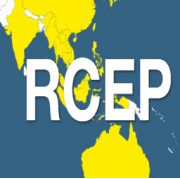Why did India not sign the world largest RCEP trade deal?
On November 15, 2020, China and other fourteen Asian countries signed the world largest trade pact under the RCEP of ASEAN grouping. The agreement left the doors open for India. However, in 2019, India walked out of the agreement.
Why did India not sign the agreement?
- According to India, the deal does not address its demands adequately. This includes issues of market access along with protected list of goods and services that shield the domestic economy. Under the RCEP deal, China is the major economy. This will pave way for cheap Chinese imports to enter India. Because, if India signs the deal, it will have to remove duties that are currently imposed. This will result in mass dumping of Chinese goods and will ultimately affect domestic production. India is already facing trade deficit of 5.8 billion USD (as of June 2020) with China.
- India was also skeptical about the fact that, under the deal, India has to open 74% of its market to ASEAN countries. On the other hand, richer economies like Indonesia is opening only 50% of their markets to India.
- Also, the RCEP deal will affect the dairy and agricultural sector of India to large extent. Countries like New Zealand is producing nine times more dairy products than its own requirement. This will make it easier for the country to make their dairy exports to India cheaper affecting the domestic milk industry.
Demands of India rejected by the pact
India wanted RCEP to exclude the Most-Favoured Nation obligation. India demanded the exclusion especially for the countries with which it had border disputes.
How will the decision impact India?
- The experts have raised concerns that the decision will impact the bilateral trade ties of India with the RCEP members. This is mainly because, the members might incline to focus on bolstering economic ties within the bloc.
- There are also concerns that the decision might impact Australia-India-Japan network in the Indo-Pacific.
- India has trade deficit with 11 out of 15 RCEP countries. It has been facing difficulties to leverage its existing bilateral FTAs (Free Trade Agreements) with the RCEP members in order to increase the exports.
Way Forward
The doors are still open for India to join the RCEP deal. And Japan had a major role for RCEP to keep the doors open for India. The possible alternative option for India is to renew its existing bilateral Free Trade Agreements with its RCEP members. Currently, India has FTAs with members such as South Korea, ASEAN bloc and Japan. It is negotiating with members such as Australia and New Zealand. India and Singapore have completed two reviews of CECA (Comprehensive Economic Cooperation Agreement). In 2016, India and Bhutan renewed the Trade Commerce and Transit. Also, in 2016, India and Nepal renewed the India-Nepal Treaty of Trade. Eight rounds of negotiations have been completed to review India-Korea CEPA (Comprehensive Economic Partnership Agreement).
Month: Current Affairs - November, 2020


